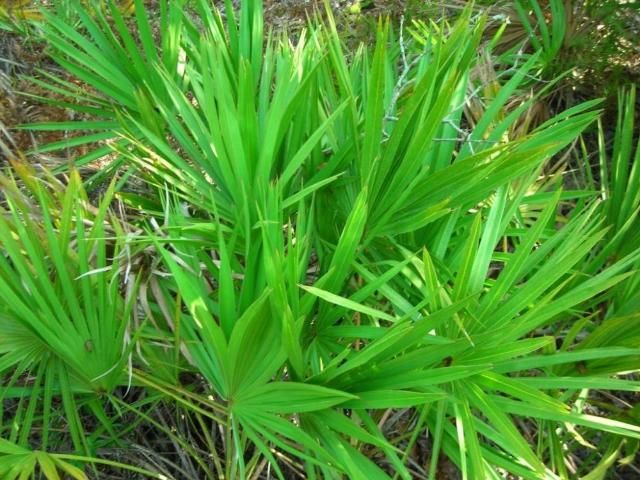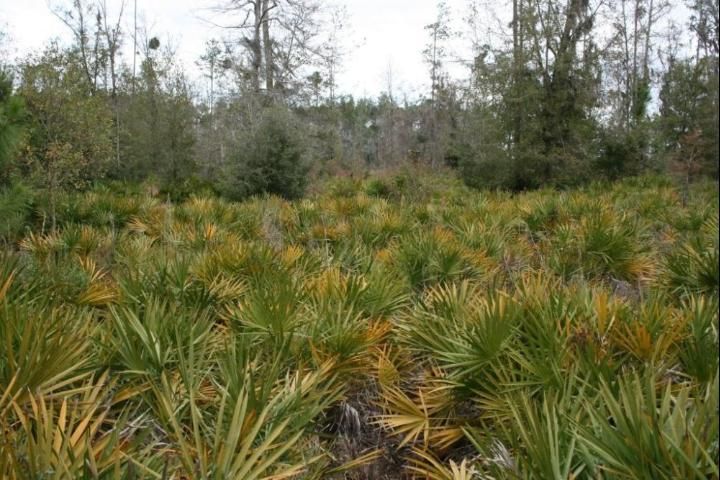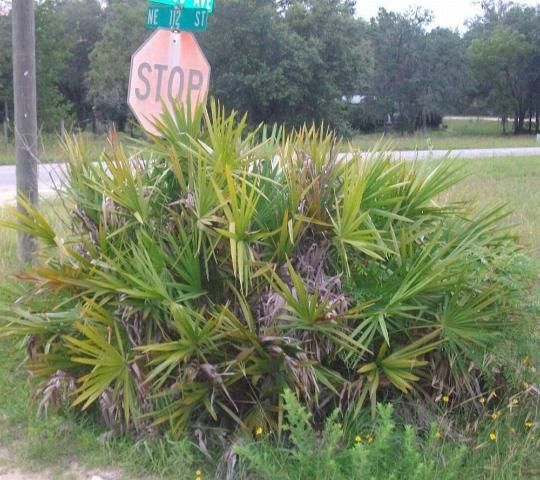Saw palmetto [Serenoa repens (Bartram) Small] is a shrubby palm species native to Florida and common throughout the state. Plants are typically 2 to 8 feet tall. They arise from subterranean or prostate stems and may grow in clumps up to 18 feet in diameter. The palmate leaves of saw palmetto are 2 to 3 feet in diameter and are borne on sharply saw-toothed petioles (leaf stems) that are approximately 2 feet long (Figure 1). Flowering occurs between February and April on branches that are approximately 2 feet long, and flowers produce round fruits called "drupes" that are 0.5 inches in diameter and ripen from September to October. Refer to EDIS publication WEC109 (https://edis.ifas.ufl.edu/uw110) for further information concerning saw palmetto biology and ecology.

Saw palmetto leaves and drupes provide cover and food for over 211 species of wildlife. Drupes can also be consumed by humans, and they have reportedly been used for the treatment of 63 commonly occurring medical conditions. Despite its beneficial uses, saw palmetto is a serious weed problem in pastures, forests, and non-cropland areas throughout Florida (Figure 2). Saw palmetto competes with desirable native plant species in forests, prevents access to power poles and other utility structures in non-cropland areas, reduces forage yield and quality in pastures, and hinders ranching operations by reducing visibility and accessibility to livestock (Figure 3). For these reasons, control of this common native plant is often necessary.


Mechanical Control
The massive underground stems and waxy leaves of saw palmetto make it an extremely difficult plant to control. Double roller-chopping (chopping twice in perpendicular directions) can effectively control saw palmetto; however, this procedure is extremely labor intensive, costly, and non-selective, which means that it causes damage to desirable plant species. Consider carefully before beginning a roller-chop program. For more information on roller-chopping and other mechanical treatments for saw palmetto, please see EDIS publication SS-AGR-105 (https://edis.ifas.ufl.edu/ag173).
Chemical Control
Control of saw palmetto can be accomplished by either spot-treating individual clumps or by broadcast spraying larger infestations. Spot-treatments can be made using either a backpack sprayer or a motorized sprayer mounted on a tractor or ATV. When making spot-treatments, treat the entire plant and achieve good spray coverage, but do not allow spray runoff.
For spot-treatment applications, using metsulfuron alone (the active ingredient in MSM 60, Cimarron, Ally, and others) will rarely be effective (Table 1). However, using triclopyr ester alone (triclopyr ester is the active ingredient in Remedy Ultra, Garlon 4, and many other products) is not a great deal better. With triclopyr ester, even at a 4% solution, you will observe rapid brown-out of all treated foliage and the plant will appear to be dead, but within a single year of the application, new sprouts will form at the base of the plant, and the plant will need to be retreated. With metsulfuron, total brown-out rarely occurs, but no new sprouts will emerge. Applying metsulfuron alone will cause saw palmetto to slowly decline with yellow/green leaves remaining on the plant for the rest of the natural life of the plant. Triclopyr ester and metsulfuron mixed together usually provide more effective palmetto control. It seems that the triclopyr ester provides the leaf browning, while the metsulfuron helps to reduce resprouting. Regardless of whether you choose triclopyr ester, metsulfuron, or the combination, you will not likely achieve 100% control with one application. It is usually necessary to make a second herbicide application 8 to 12 months after the first.
When broadcasting herbicides on palmetto, it is important to increase the application volume to between 20 and 40 gallons of water per acre with either a crop oil or methylated seed oil adjuvant. Adequate spray coverage and proper adjuvant are essential for good control. For broadcast applications, results were similar to that of the individual plant treatments. Triclopyr ester plus metsulfuron combinations were required for maximum control. Replacing triclopyr with fluroxypyr (Vista XRT or Cleanwave) or aminopyralid (one of the components of Chaparral) was less effective. In broadcast applications as in individual plant treatments, none of the herbicide combinations tested provided 100% control. Follow the broadcast application with either an additional broadcast or spot-spray to control palmetto resprouts.
Metsulfuron is useful for broadcast application to pastures, with some precautions. Metsulfuron is highly effective on blackberry and many other weeds, but will also severely injure or kill Pensacola bahiagrass. If a sufficient population of bahiagrass is present in the palmetto-infested area, metsulfuron should only be used in spot-spraying or limited broadcast applications. Additionally, the maximum use rate for a metsulfuron product (with 60% active ingredient) in pastures is 1.66 oz of product per acre per year, or 0.06 lb active ingredient per acre. Use rates for forestry or industrial sites can exceed 1.66 oz/A/yr, but consult the product label before you apply.
For additional information on individual plant treatment and broadcast herbicide applications, see the following publications:
Herbicide Application Techniques for Woody Plant Control, EDIS Publication No. SS-AGR-260. (https://edis.ifas.ufl.edu/ag245)
Broadcast Boom Sprayer Calibration, EDIS Publication No. PI24. (https://edis.ifas.ufl.edu/pi016)